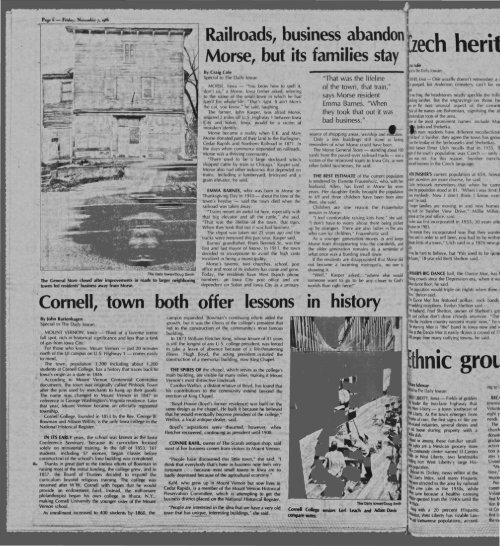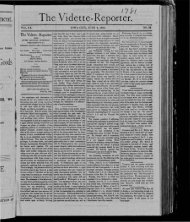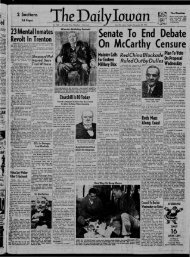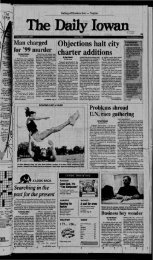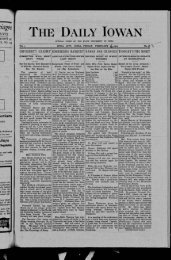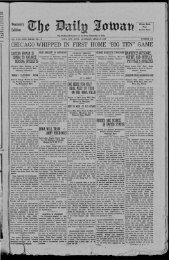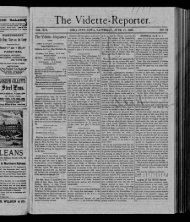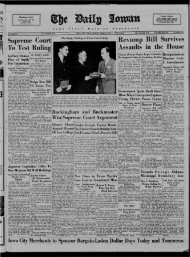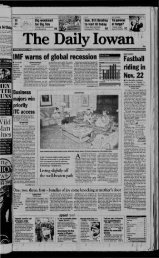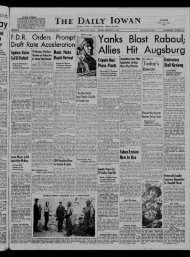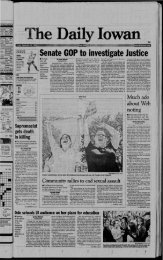Hawkeye
View - The Daily Iowan Historic Newspapers - The University of Iowa
View - The Daily Iowan Historic Newspapers - The University of Iowa
- No tags were found...
You also want an ePaper? Increase the reach of your titles
YUMPU automatically turns print PDFs into web optimized ePapers that Google loves.
The Dally IowanlDoug Smith<br />
The General Store closed after improvements in roads to larger neighboring<br />
towns led residents' business away from Morse.<br />
Railroads, business abandon<br />
Morse, but its families stay<br />
By Craig Cole<br />
pe lal to Th<br />
Daily Iowan<br />
MORSE, Iowa - "You know how to spell it,<br />
don't ya," a Morse, Iowa farmer asked, referring<br />
to th name of the small town in which he had<br />
spent his whole life. "That's right. It ain't Morris<br />
the r at, you know," he aid, laughing.<br />
The farmer, John Kasper, was afraid Morse,<br />
ituated 2 mil s off U.S. Highway 1 between Iowa<br />
ity and olon, Iowa, would be a victim of<br />
mistaken Identity.<br />
Morse becam a reality when EX and Mary<br />
Mor e donated part of their land to the Burlington,<br />
Cedar Rapids and Northern Railroad in 1871 . In<br />
th days when commerce depended on railroads,<br />
Mor, was a thriving community.<br />
HTh re used to be a large tockyard which<br />
shipped caul by train to Chicago," Kasper said.<br />
Mor e al 0 had other Industries that depended on<br />
trains, including a lumberyard, brickyard and a<br />
grain levator, he said.<br />
EMMA BARNES, who was born in Morse on<br />
Thank Siving Day in 1910 - about the time of the<br />
town's heyday - said the town died when the<br />
railroad wa taken away.<br />
"TrainS meant an awful lot here, especially with<br />
that big elevator and all the cattle," she said.<br />
"That wa~ th lifeline of the town, that train .<br />
When th y took that out it was bad business. "<br />
The depot was taken out 25 years ago and the<br />
trae.k were removed this past year, Kasper said.<br />
Barnes' grandfather, Frank Berenek Sr., was the<br />
first and last mayor of Morse. In 1911, the town<br />
deCided to in orporate to avoid the hi~h costs<br />
involved in being a municipality.<br />
Morse'~ taverns, two churches, school, post<br />
office and mo t of its industry has come and gone.<br />
Today, th re idents have West Branch phone<br />
numbf>r , an Iowa City post office and are<br />
depend nt on Solon and Iowa City as a primary<br />
"That was the I ifel i ne<br />
of the town, that train,"<br />
says Morse resident<br />
Emma Barnes. "When<br />
they took that out it was<br />
bad business."<br />
source of shopping areas, worship and eI~ion .<br />
Only a few buildings still stand as lasting<br />
reminders of what Morse could have been.<br />
The Morse General Store - standing about 100<br />
yards from the paved-over rai lroad tracks - was a<br />
victim of the improved roads to Iowa City, as were<br />
other failed businesses, he said.<br />
THE BEST ESTIMATE of the current populatldn<br />
is tendered by Danelle Frauenholz, who, with her<br />
husband, Allen, has lived in Morse for seven<br />
years. Her daughter Emily brought the population<br />
to 69 and three children have been born since<br />
then, she said .<br />
Children are on reason the Frauenholtzs<br />
remain in Morse.<br />
HI feel comfortable raising kids here," she said.<br />
"I don't have to worry about them being picked<br />
up by strangers. There are also ladies in the area<br />
who care for children." Frauenholtz said.<br />
As a younger generation moves in and keeJh<br />
Morse from disappearing into the cornfields, and<br />
the older generation remains a a reminder of<br />
what once was a bustling small town.<br />
If the residents are disappointed that Morse did<br />
not become a booming metropolis, no one is<br />
showing it.<br />
"Well," Kasper asked, "where else would<br />
someone want to go to be any closer to God's<br />
worlds than right here?"<br />
Cornell, town both offer lessons in . history<br />
By John Bartenhagen<br />
pecial to The Daily Iowan<br />
MOUNT VERN N, Iowa - Think of a favorite s enic<br />
fall spot, rich in hi torieal significance and less than a tank<br />
of ga from Iowa City.<br />
For tho e who know, Mount Vernon - JU t 20 minut<br />
north of the UI campu on U.S. Highway 1 - comes easily<br />
to mind.<br />
The town, population 3,200 10 luding about 1,200<br />
student at Cornell College, has a history that trace ba k to<br />
Iowa' origin a a state in 1846.<br />
According to Mount Vernon Centennial Committee<br />
documents, the town was originally called Pin hook Town<br />
after the pins used by merchants to hang up their goods.<br />
The name was chan ed to Mount Vernon in 1847 In<br />
reference to George Wa hington's Virginia residence. Lat r<br />
that year, Mount Vernon became an officially registered<br />
town hip.<br />
Cornell College, founded in 1853 by the Rev. George B.<br />
Bowman and Allison Willit , is the only Iowa college 10 the<br />
National Historical Register.<br />
IN ITS EARL V years, the school was known as the Iowa<br />
Conference Seminary, because its curriculum focused<br />
solely on ministerial training. In the fall of 1853, 161<br />
students, including 57 women, hegan classes before<br />
construction of the school's lone building was completed.<br />
Thanks in great p~rt to the tireless efforts of Bowman in<br />
raising most of the initial funding, the college grew, and in<br />
1857, the Board of Trustees decided to expand the<br />
curriculum beyond religious training. The college was<br />
renamed after W. W. Cornell with hopes that he would<br />
provide an endowment fund. Instead, the millionaire<br />
philanthropist began his own college in Ithaca, N. V.,<br />
making Cornell University the younger sister of the Mount<br />
Vernon school.<br />
As enrollment increased to 400 students by 1860, the<br />
campu expanded. Bowman' continuing effort aided the<br />
growth, but it was the illness of th college's president that<br />
led to the construction of the community's most famous<br />
buildlOg.<br />
In 1873 William Fletcher King, whose tenure of 43 years<br />
is still the longe t of any U.S. college president, was forced<br />
to take a leave of absence because of a life-threatening<br />
din 55 . Hugh Boyd, the acting president, in itiated the<br />
construction of a memorial building, now King Chapel.<br />
THE SPIRES OF the chapel, which erves as the college's<br />
main building, are visible for many miles, making it Mount<br />
Vernon's most distinctive landmark.<br />
Carolyn Wellso, a distant relative of Boyd, has found that<br />
hi contributions to the community extend beyond the<br />
erection of King Chapel.<br />
"Boyd House (Boyd's former residence) was built on the<br />
arne design as the chapel. He built it because he believed<br />
that he would eventually become president of the college,"<br />
Wellso, a local antique dealer, said.<br />
Boyd's aspirations wer~ thwarted, however, when<br />
Fletcher recovered, continuing as president until 1908.<br />
CONNIE KAHL, owner of The Scarab antique shop, said<br />
most of her business comes from visitors to Mount Vernon.<br />
"People have discovered this little town," she said. "I<br />
think that everybody that's here in business now feels very<br />
fortunate . . . because most small towns in Iowa are so<br />
badly depre sed because of the agricultural economy."<br />
Kahl, who grew up in Mount Vernon but now lives in<br />
Cedar Rapids, is a member of the Mount Vernon Historical<br />
Preservation Committee, whieh is attempting to get the<br />
business district placed on the National Historical Register.<br />
NPeople are interested in the idea that we have a very old<br />
town that has unique, interesting buildings,· she said.<br />
The Deily IOW81liD!'g Smith<br />
Cornell Col. seniors Lori Leach and Adam Davis<br />
~notfl.<br />
ech heril<br />
Iowa - One usually doesn't remember a «<br />
~ gra~eyard , but Anderson c metery can't be 0<br />
JMe thing, the headstones neatly speckl the hi 1\<br />
log SWisher. But the engravings on those h<br />
are the most unusual aspee.t of the cernet.<br />
all the names are Bohemian, signifying the d<br />
·makian roots of the area.<br />
of the most prominent names include Mar<br />
I , lanko and Shebetka.<br />
many residents have different recoil<br />
''*1 days' in Swisher, they agree the town has<br />
e the heyday of the Serbou eks and Shebetkas.<br />
red banker Elmer Ulch recalls that in 1935,<br />
en! of the town's population was Czech - only<br />
was not. For this reason , Swisher<br />
.:ned business in the Czech language.<br />
~11H SWISHER'S current population at 654,<br />
0I!I1IS' ancestries are more diver e, he said .<br />
G.vlie Serbousek remembers that when he<br />
~ thepopulatlon stood at 81 . "Wh n I was (first)<br />
\i'fW everybody. Now I don't think I know<br />
. lent: he said.<br />
runger families are moving in and new<br />
!xIilt on Swisher View Drive," Millie Mil<br />
i'btee at the post office, said.<br />
,I\herwas first incorporated 10 1933, 30 years<br />
lion in 1903.<br />
'!if reason they incorporated was that they wan<br />
~ and in order to sell beer, you had to be wit<br />
ate limit of a town," Ulch said 10 a 1976<br />
tmay be hard to believe, but "this u ed to be qu<br />
haven,' 18-year-old Brett Shelton aid.<br />
1lI1SHER'S BIG DANCE hall , the Dance Mor, has<br />
Iltlng crowds since the 0 pression era, when it<br />
-hlr dance floor, he aid.<br />
'1I-f population would triple on nights when there<br />
" Shelton said.<br />
!he Dance Mor has featured polka~ , rock bands<br />
wedding receptions, Evelyn Shelton aid.·<br />
I!r husband, Fred Shelton, own r of helton's<br />
, said polkas don't draw crowds anymor .<br />
lIIto the modern country we~tern mu Ie. now/ he<br />
!he Morning After is "the" band in Iowa now and<br />
~ at the Dance Mor it easily draw a crowd of<br />
(Q)people from many outlying towns, he said .<br />
thnic gro<br />
~~I. Soloway<br />
~Ial to The Daily Iowan<br />
~TlIBERTY, Iowa - rlelds of gold n<br />
border the two-Ian highway that<br />
West Liberty - a townouth (1St of<br />
liberty. As the town emerge (rom<br />
miles of corn, the (ir t igns of life are<br />
~ated industries, s v ral din rs and<br />
old house sharing property With a<br />
~Iitedish.<br />
~ in among these familiar small<br />
'-n sights are a Mexican grocery store<br />
~a community center named EI entro<br />
~ de West liberty, two landmark<br />
~ng from West liberty'S large Hi .<br />
~ population.<br />
llristine M. Dickey, new~ editor ilt the<br />
liberty Index, said many Hi panic<br />
. Were anracted to th area by railroad<br />
~. crew jobs in the 1930, while<br />
~'\TI came because a healthy annlng<br />
~ operated from the 1940 until the<br />
~I%Os .<br />
~8 with a 20 per ent Hi pani<br />
~ij(ion, West Liberty has izable Lao·<br />
~ Vietnamese population, a cord<br />
ing to


